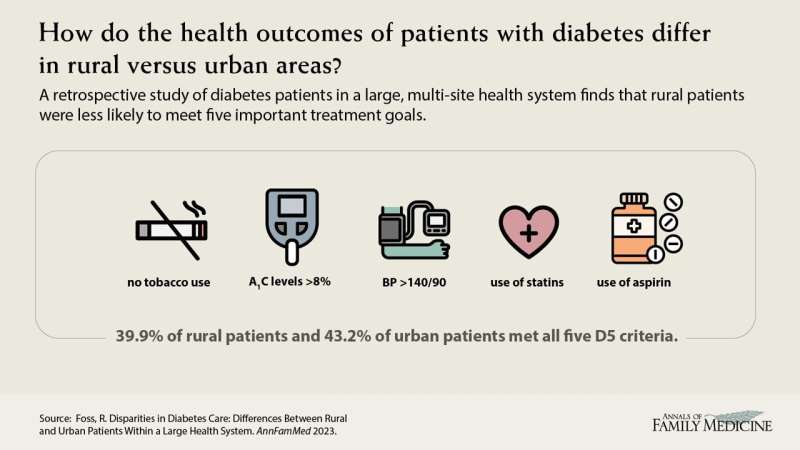This article has been reviewed according to Science X's editorial process and policies. Editors have highlighted the following attributes while ensuring the content's credibility:
fact-checked
peer-reviewed publication
trusted source
proofread
Rural patients with diabetes experience worse health outcomes than urban patients

Mayo Clinic researchers conducted a study within their health care system to identify factors associated with quality of care among rural and urban patients with diabetes.
The study evaluated patient attainment of a five-component diabetic care metric, known as the D5 metric. This metric includes no tobacco use, hemoglobin A1C <8%, blood pressure <140/90, statin use, and aspirin use. Researchers considered age, sex, race, Adjusted Clinical Group score (a series of mutually exclusive, health status categories defined by morbidity, age, and sex), insurance type, primary care clinician type, and health care use data.
Researchers analyzed records from 45,279 patients with diabetes receiving treatment from primary care providers. 54.4% of these patients lived in rural locations. 39.9% of rural patients and 43.2% of urban patients (P<0.001) met all five D5 criteria. Rural patients were significantly less likely to have attained all metric goals than urban patients (AOR 0.93 [95% CI 0.88-0.97]). Compared to patients in urban areas, rural patients had fewer outpatient visits (mean visits 3.2 vs. 3.9, P<.0001) and fewer endocrinology visits (5.5% vs. 9.3%, P<.0001)
Patients with an endocrinology visit during the study period were less likely to meet metric goals (0.80 [95% CI 0.73-0.86]). The reason for this could be that seriously ill patients are typically referred to endocrinologists. The number of outpatient visits was positively associated with metric goal attainment (1.03 [95% CI 1.03, 1.04]).
Researchers concluded that rural patients had worse diabetic quality outcomes than their urban counterparts, even after adjusting for other contributing factors and despite being part of the same integrated health system. The team speculated that decreased visit frequency and specialty involvement in the rural setting were possible contributing factors to this disparity.
What we know:
Type 2 diabetes is a growing national health concern in the United States, with approximately 11% of the population living with the disease. Researchers assert that it's critical to know more about the complex issues that contribute to successful treatment of diabetes and its comorbid disorders. Of the many social determinants of health that have an impact on diabetes, rurality plays a role in the higher likelihood that a person will be diagnosed with diabetes.
What this study adds:
The researchers determined that rural patients have worse diabetic quality metrics than their urban counterparts, in spite of participating patients belonging to the same integrated health system and differences in doctors and clinic settings. Visit frequency and specialty doctor involvement are possible contributing factors to disparities although the study accounted for these differences in patient-level health usage. Authors argue that broader interventions need to be created to improve the way doctors care for patients with diabetes who live in rural settings.
The findings are published in The Annals of Family Medicine journal.
More information: Randy Foss et al, Disparities in Diabetes Care: Differences Between Rural and Urban Patients Within a Large Health System, The Annals of Family Medicine (2023). DOI: 10.1370/afm.2962




















